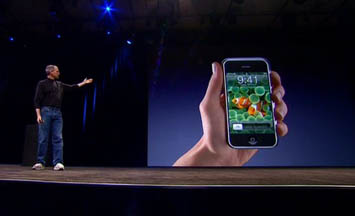
To follow-up on last week’s maelstrom of anti-Appledom, my opinions regarding the iPhone have not changed: the device will eventually be pretty awesome, but paying $600 (the effective cost is closer to a solid grand when you factor in the value of the two-year contract you’ll be signing and the fact that many early adopters will likely be also fronting the bill from terminating their T-Mobile or Sprint deal) for this thing now is foolish. And it’s not just because of the potential for bugs (which is, obviously, little more than me speculating at this point), but because Apple seems poised to set the iPhone up for a slam dunk of planned obsolescence.
Read on to see why.
It’s no secret that the first-generation iPhone will be short on features: it lacks GPS, 3G network support, native IM support, MMS, and enterprise email support, to name a few of the more glaring omissions. What’s frustrating about all this is not merely the lack of basic features, but just how easy it would be for Apple to include most of these things. After all, we’re talking about things that have come standard on free-with-contract phones for years (I was IMing on my phone back in 2001), and would cost Apple essentially nothing to include.
Furthermore, just about every missing feature is something that really could improve the iPhone in a very particular and significant way — either by complementing existing features in ways that make them more useful, or because they are things we’ve come to expect from a phone that bills itself as feature-rich, entertainment-centric, and fun.
Take the missing GPS. The factory-born inclusion of Google Maps is a major selling point of the iPhone (it’s featured in the ads!). However, its functionality lags behind that of other phones — such as the BlackBerry 8800 — that successfully merge it with their GPS receivers. If somebody has yet to explore this very cool application, having it handed to them right out of the box may sound neat — until you show them another phone where the program instantly homes in on your location.
And take the lack of both IM and enterprise email support. This effectively jams the iPhone into this bizarre middle ground between the BlackBerry and the Sidekick — that is, it is similarly useless for both businessmen and their IM-addict children. Of course, it must noted that the lack of a real keyboard will be a lot less bothersome considering how few opportunities this will leave people for typing.
What really irks me is not only the fact that these are obviously all features that are within Apple’s means to include, or that they are ones that people would have actually used, but that Apple undoubtedly knows all this and, more than likely, is planning to roll out phones loaded with some or all of them in the near future — a move that would make owners of the first-gen iPhones seem like wielders of outdated technology. It almost feels like these were features that were stripped from the first-gen iPhone consciously and for no other reason than because they could. In other words: It points to a very pointed case of future planned obsolescence.
Apple is notorious for downplaying the importance of any feature that isn’t found on their current line of products. Take mobile video — right up until the release of the 5G iPod, Steve Jobs made numerous public statements saying that nobody had any use for watching video on a tiny screen. Apple may make claims that they have only packed the iPhone with the features that customers want, but that doesn’t mean they aren’t consciously plotting ways to turn a product that isn’t even out yet into an obsolete product.

Seth Porges writes on future technology and its role in personal electronics for his column, The Futurist. It appears every Thursday and an archive of past columns is available here.